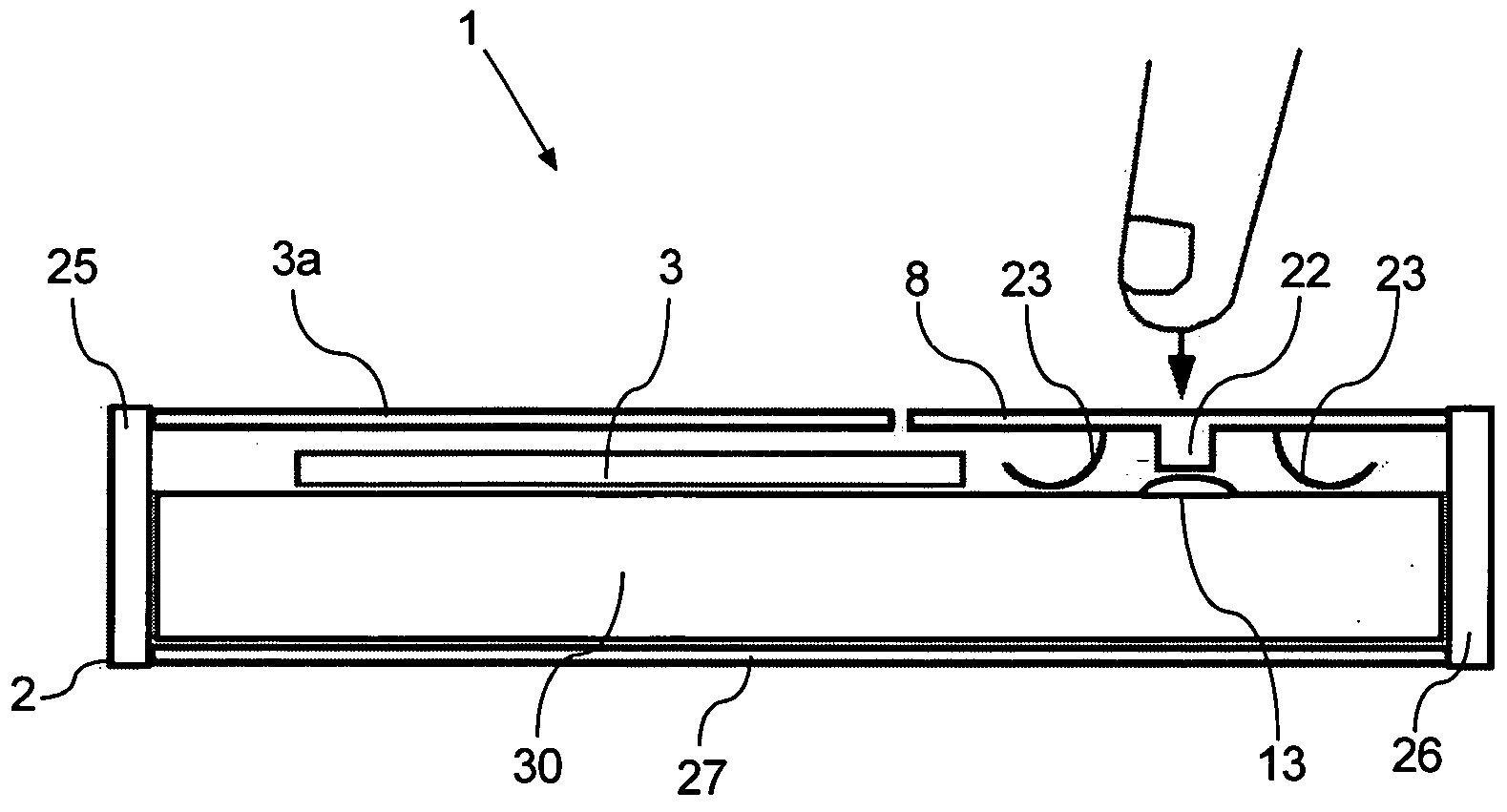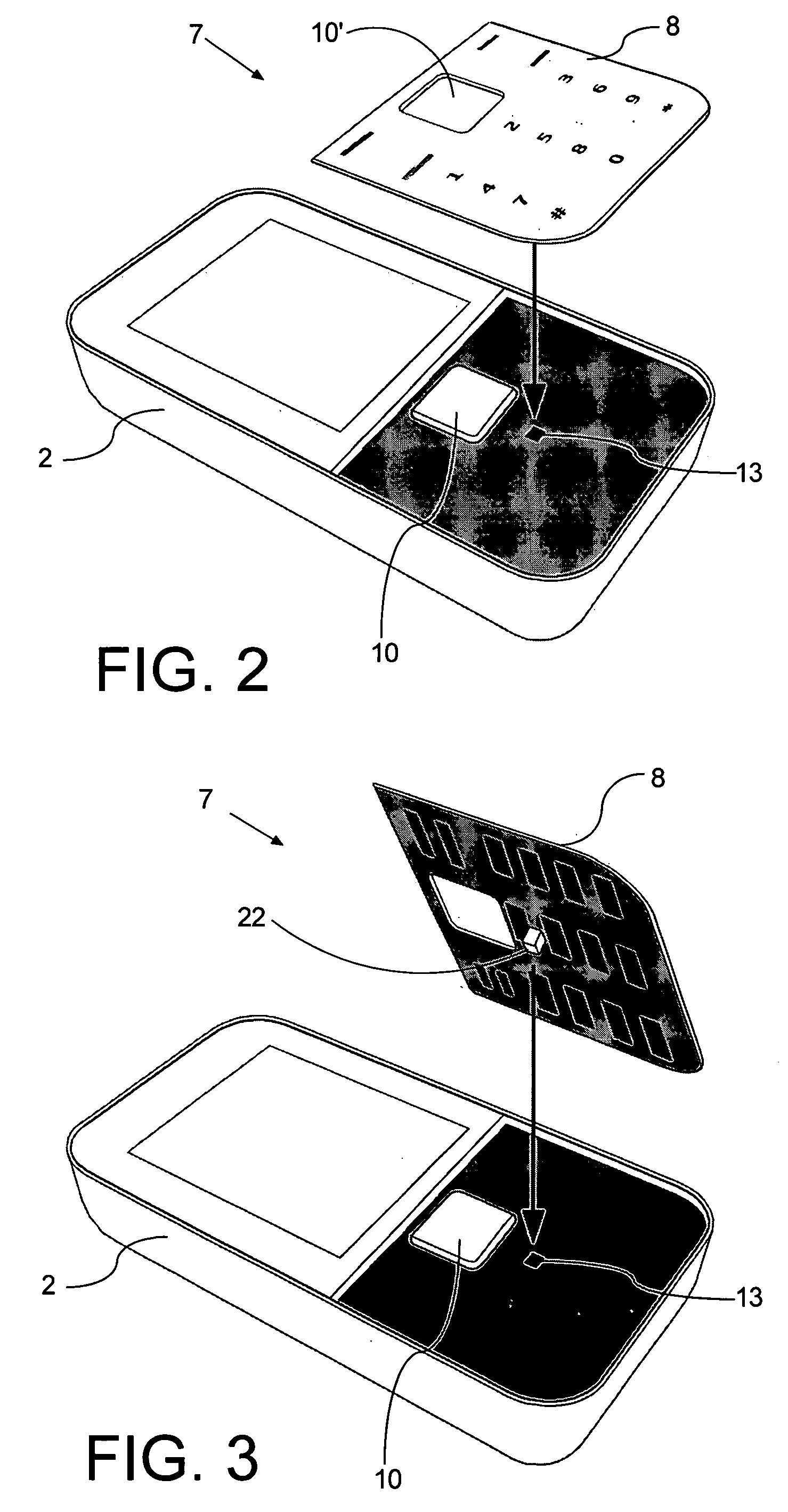Touch sensitive keypad with tactile feedback
a tactile feedback and keypad technology, applied in the field of keys and keyboards, can solve the problems of high requirements on the size and weight aspect of electronic devices with a user interface, often faced with heavily contradictory requirements, and especially contradictory requirements
- Summary
- Abstract
- Description
- Claims
- Application Information
AI Technical Summary
Benefits of technology
Problems solved by technology
Method used
Image
Examples
first embodiment
[0049]FIG. 1 illustrates a keypad according to the invention implemented in a mobile telephone by a front view. The mobile phone 1 comprises a user interface having a housing 2, a display 3, an on / off button (not shown), a speaker 5 (only the opening is shown), and a microphone 6 (not visible in FIG. 1). The phone 1 is adapted for communication via a cellular network, such as the GSM 900 / 1800 MHz network, but could just as well be adapted for use with a Code Division Multiple Access (CDMA) network, a 3G network, or a TCP / IP-based network to cover a possible VoIP-network (e.g. via WLAN, WIMAX or similar) or a mix of VoIP and Cellular such as UMA (Universal Mobile Access).
[0050]The keypad 7 has a first group of keys as alphanumeric keys, by means of which the user can enter a telephone number, write a text message (SMS), write a name (associated with the phone number), etc. Each of the twelve alphanumeric keys is provided with a figure “0-9” or a sign “#” or “*”, respectively. In alph...
second embodiment
[0063]FIG. 9 shows the keypad 7 when it is depressed in a central position, e.g. when the user presses hard enough on the key marked “5”. When the plate member 8 is in this position an electrical contact is established (contacts not shown, but could be formed by the collapsible ring 33 in collaboration with a ring contact disposed on the printed circuit board 36).
[0064]FIG. 10 shows the keypad 7 according to the second embodiment when it is depressed in an off-center position, e.g. when the user presses hard enough on a key along the periphery of the keyboard. When the plate member 8 is in this position an electrical contact is established.
[0065]Thus, in the second embodiment the biased switch 13 is formed by the collapsible member 33 in combination with contacts.
[0066]The concept of a ring shaped collapsible member supporting a plate member is not limited to the combination with touch sensors, keypads or other user interface components on the plate member. Neither does the ring sh...
third embodiment
[0067]FIGS. 11 and 12 show the keypad 7 according to the invention. The keypad comprises a plurality of keys 44. A touch sensor 14 is placed on the top of each key 44. A slidable plate member 41 is disposed under the keys 44. The slidable plate member is suspended between two parallel guide rails 43 and can slide back and forth as indicated in the double headed arrow inFIG. 11. A biased switch 13 is arranged to face one of the edges of the plate member 41. The resilient characteristic of the biased switch urges the slidable plate member 41 to an idle or return to position.
[0068]The slidable plate member 41 includes a plurality of recesses or holes 42 that equals the number of keys 44. The recesses or holes 42 are provided with a slanting edge 48 that collaborates with a slanting surface 47 that is provided on a protrusion of 46 on the underside of the keys 44. The slidable plate member 41 is urged by the switch 13 to assume the position indicated in FIG. 12.
[0069]When one of the key...
PUM
 Login to View More
Login to View More Abstract
Description
Claims
Application Information
 Login to View More
Login to View More - R&D
- Intellectual Property
- Life Sciences
- Materials
- Tech Scout
- Unparalleled Data Quality
- Higher Quality Content
- 60% Fewer Hallucinations
Browse by: Latest US Patents, China's latest patents, Technical Efficacy Thesaurus, Application Domain, Technology Topic, Popular Technical Reports.
© 2025 PatSnap. All rights reserved.Legal|Privacy policy|Modern Slavery Act Transparency Statement|Sitemap|About US| Contact US: help@patsnap.com



